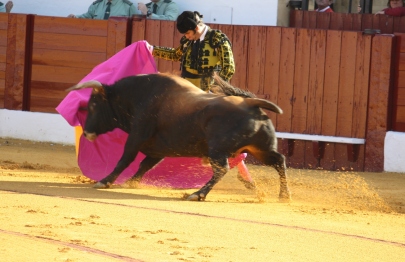To celebrate the tenth anniversary of my own first visit to Zahariche, the legendary ranch of my friends the Miura family – the most famous breeders of Spanish fighting bulls in history – and in this difficult time for all taurinos, I thought I would translate this interview with Don Eduardo Miura in the Spanish newspaper ABC.
Alexander Fiske-Harrison

Click here to read the original story (in Spanish)
Miura: «Muchos toros de Pamplona acabarán en el anonimato de un matadero»
The mythical cattle from the ranch of Zahariche, saint and symbol of Pamplona, close each year the Feria de San Fermín
A dark silence ran through the world of bullfighting at the suspension of the Fiesta of the fury in red and white: not bull-runs nor bullfights, nothing. The cancellation of the Feria del Toro enlarges even further the shadow of the crisis in the world of bull-breeding.
“This season is a ruin,” is the unanimous voice. Although the cartels were not yet known – the Bullfighting Commission suspended the contracting of the bullfighters in March when they first heard the sounds about the State of Emergency – the Casa de la Misericordia had already decided on the ranches in December, nine bullfights and one novice bullfight, sixty bulls will stay in the countryside: Pincha, Capea, La Palmosilla, Núñez del Cuvillo, Victoriano del Río, Jandilla, Fuente Ymbro, Cebada Gago, José Escolar and Miura.

Miuras – Eduardo Miura, AFH, Antonio Miura, and the matador Eduardo Dávila Miura in the finca ‘Zahariche’ in 2010 (Photo: Lucy Gould)
And now in one of the scenes where usually the main part of the money is paid to the ranches, and then their very best bulls are sent to the Corrals of Gas in the City, yet another setback is delivered to this most affected sector of the economy, where there is no income and everything is expenses:
“Animals must be cared for and fed daily,” says Eduardo Miura. The ranch of ‘Zahariche’, saint and symbol of Pamplona, was going to sent yet another perfect group of bulls for the Sanfermines on July 14.”
“I imagined it would not be celebrated this year but this is a very cruel blow. We have been there for fifty years without missing a single one, except during the riots of ’78. This coronavirus is crushing us; in addition to health, it is going to have a very negative impact on global tourism and the economy. ”

AFH trains with a young Miura in Zahariche in 2010 (Photo AFH personal collection)
The Fiesta of Pamplona was one of the eight bullfights that the Miura had lined up for 2020, around fifty bulls whose final time “may be the slaughterhouse”, without the honors of the bullring.
“We have raised them with the greatest care to be dealt with in rings like Seville or Pamplona, and now the destiny of many may be to be sacrificed in the anonymity of a slaughterhouse. It is a real shame.”

AFH and Juan José Padilla in the ring together (AFH personal collection)
Miura, the brand of bull with which the matador Juan José Padilla was crowned the eternal hero in San Fermín, had prepared for Pamplona bulls from Cuatreños to Cinqueños [Four- to five-years-old, no bull of six years or older may enter the ring by Spanish law – AFH] but he knows that not even all four-year-olds will be able to contend in 2021 either:
“There will be an excess of bulls out in the fields, prices will drop, expenses will continue … And I do not expect much help from a government that is not very friendly to the activity to which I have dedicated myself.”
The Casa de la Misericordia of Pamplona plans to give preference to the livestock contracted for this year at the next fair [in 2021], but even so “the economic damage is going to be very heavy, and each one will have to get out of this crisis as best they can.”

AFH, first ever bull-run – with Miuras in Pamplona – circled right – July 12th, 2009 (Photo AFH personal collection)



